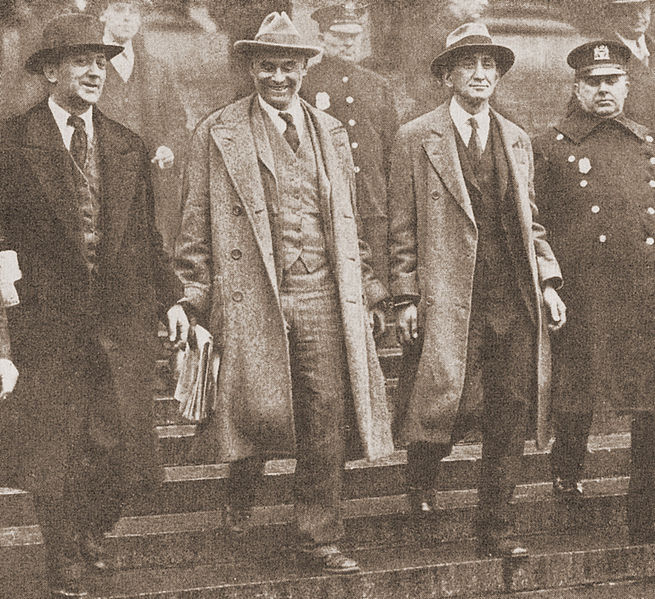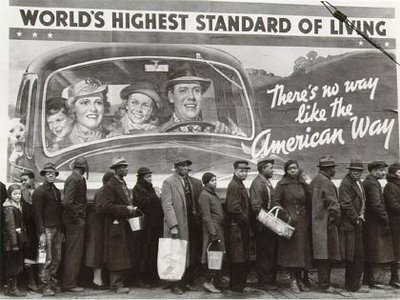Ephraim Ben Raphael
Banned
Things get bad- 1930-31
In the beginning of the year 1930 prominent persons whose word was apt to be taken seriously, declared their confidence in stocks and underlying business soundness. Even comic strip characters weighed in, “Who says business is bad?” asked Little Orphan Annie. Not Nicholas Butler, the president of Columbia University; Dr. Butler assured Columbia men that “Courage will end the slump.” Not the president of U.S. Steel; he said the “peak” of the Depression had passed. Not Owen D. Young, board chairman of General Electric; he announced that the “dead center of the Depression” had come and gone. Not a spokesman for the National Association of Manufacturers; he observed that “many of the bad effects of the so-called Depression are based on calamity howling.” Not Secretary of the Treasury Andrew Mellon who asserted that there was “nothing in the present situation… menacing or [warranting] pessimism.” And certainly not Secretary of Commerce Thomas Lamont; he reported that “The banks of this country are in a strong position” and contented himself with listing the gains that the year 1929 had made over 1928, and predicting prosperity “in the long run.”
It was going to be a very long run.
By March of 1930 there were between 3,250,000 and 4,000,000 unemployed in the United States of America, by March 1931 those numbers had doubled to between 7,500,000 and 8,000,000. Appreciable downward changes in m manufacturing wages began in the fourth quarter of 1930, there was a general understanding among employers that high wages were necessary for recovery and so they held off on making cuts for as long as they could. This changed in August 1931 when U.S. Steel cut the salaries of its employees by 10 to 15 percent and was soon followed by the rest of the steel industry. Throughout 1931 3586 concerns cut wages for some 654,687 workers, by the end of the year hourly earnings had hit 54 cents per hour. Average weekly earnings fell even faster, in 1929 the average weekly salary of an industrial worker was above $28.50, for 1930 $25.74, and a mere $22.64 for 1931. Working hours fell from 48 per week in 1929 to 44 in 1930, to a mere 38 in the last months of 1931. Increasingly even those who were still employed watched their circumstances become more and more precarious.

Unemployed workers warming themselves over trashcan fire.
It was in the growing masses of the unemployed that the seeds of radicalism began to take hold. In 1930 the Unemployed Councils of the USA (UCU) was first organized by the American Communist Party, then a tiny organization with about 10,000 members. Similar to the soviets of unemployed workers that emerged during the 1905 Russian Revolution, the UCU was a loosely organized body based around neighborhood councils composed of alienated and disillusioned unemployed. Little co-operation existed between respective UCU councils, and in fact most of the membership had not much interest in communism. Demanding public works, relief, and state aid, the UCU was often little more than an expression of American progressive thought. However, communist organizers were very active in the movement and they were able to present their teachings for the first time to a large number of Americans- clearing ground for the expansion of the party.

A meeting of the St. Louis Unemployment Council. Note the multiracial nature of the membership.
On March 6, 1930 the “International Struggle against Worldwide Unemployment” was called by the Communist International. Across the United States some 100,000- 200,000 members of the UCU turned out to protest calling for “Work or Wages” and demanding that President Hoover do something to address the issue of unemployment. Law enforcement cracked down on the organization, arresting many of its leaders including William Z. Foster, but the diffuse nature of the UCU’s structure meant that the government response helped the councils more than it hurt them. The free publicity caused Unemployment Councils to swell, and although the Communist Party would attempt to establish a more rigid hierarchy for the councils later that year they were never truly able to control their creation.

From left to right; William Z. Foster, Robert Minor, and Israel Amter. The three communists and leaders of the UCU being arrested on March 6, 1930 for connection to the Unemployment Day Protests.
On October 16, 1930 as unemployed and police skirmished in the streets of New York, Sam Nessin, one of the leaders of the New York Unemployed Councils addressed the city council calling for relief. Mayor Jimmy Walker condemned Nessin calling him a “dirty Red” at which point police beat the activist and four of his companions with nightsticks and removed them from the hall. Nessin was later charged with “inciting riot”. Meanwhile Unemployed Councils stormed supermarkets and organized protests nationally, recruiting from amongst the disenfranchised and the desperate. Their willingness to recruit both black and white citizens both hurt and helped the UCU’s appeal in the south, in the north they frequently made inroads into immigrant communities.
Largely thanks to their involvement in the Unemployed Councils, the Communist Party swelled massively- by the end of 1931 they had increased ten-fold with some 100,000 members. Still neither they, nor the Socialists were able to make much headway in the 1930 elections which saw the Democrats take control of both houses. For the time being Congress remained the province of the Democrats and Republicans (excepting a single representative and a single senator both belonging to the Farmer-Labor Party). The political fragmentation that would emerge later in the thirties was yet to come.
In the beginning of the year 1930 prominent persons whose word was apt to be taken seriously, declared their confidence in stocks and underlying business soundness. Even comic strip characters weighed in, “Who says business is bad?” asked Little Orphan Annie. Not Nicholas Butler, the president of Columbia University; Dr. Butler assured Columbia men that “Courage will end the slump.” Not the president of U.S. Steel; he said the “peak” of the Depression had passed. Not Owen D. Young, board chairman of General Electric; he announced that the “dead center of the Depression” had come and gone. Not a spokesman for the National Association of Manufacturers; he observed that “many of the bad effects of the so-called Depression are based on calamity howling.” Not Secretary of the Treasury Andrew Mellon who asserted that there was “nothing in the present situation… menacing or [warranting] pessimism.” And certainly not Secretary of Commerce Thomas Lamont; he reported that “The banks of this country are in a strong position” and contented himself with listing the gains that the year 1929 had made over 1928, and predicting prosperity “in the long run.”
It was going to be a very long run.
By March of 1930 there were between 3,250,000 and 4,000,000 unemployed in the United States of America, by March 1931 those numbers had doubled to between 7,500,000 and 8,000,000. Appreciable downward changes in m manufacturing wages began in the fourth quarter of 1930, there was a general understanding among employers that high wages were necessary for recovery and so they held off on making cuts for as long as they could. This changed in August 1931 when U.S. Steel cut the salaries of its employees by 10 to 15 percent and was soon followed by the rest of the steel industry. Throughout 1931 3586 concerns cut wages for some 654,687 workers, by the end of the year hourly earnings had hit 54 cents per hour. Average weekly earnings fell even faster, in 1929 the average weekly salary of an industrial worker was above $28.50, for 1930 $25.74, and a mere $22.64 for 1931. Working hours fell from 48 per week in 1929 to 44 in 1930, to a mere 38 in the last months of 1931. Increasingly even those who were still employed watched their circumstances become more and more precarious.
Unemployed workers warming themselves over trashcan fire.
It was in the growing masses of the unemployed that the seeds of radicalism began to take hold. In 1930 the Unemployed Councils of the USA (UCU) was first organized by the American Communist Party, then a tiny organization with about 10,000 members. Similar to the soviets of unemployed workers that emerged during the 1905 Russian Revolution, the UCU was a loosely organized body based around neighborhood councils composed of alienated and disillusioned unemployed. Little co-operation existed between respective UCU councils, and in fact most of the membership had not much interest in communism. Demanding public works, relief, and state aid, the UCU was often little more than an expression of American progressive thought. However, communist organizers were very active in the movement and they were able to present their teachings for the first time to a large number of Americans- clearing ground for the expansion of the party.

A meeting of the St. Louis Unemployment Council. Note the multiracial nature of the membership.
On March 6, 1930 the “International Struggle against Worldwide Unemployment” was called by the Communist International. Across the United States some 100,000- 200,000 members of the UCU turned out to protest calling for “Work or Wages” and demanding that President Hoover do something to address the issue of unemployment. Law enforcement cracked down on the organization, arresting many of its leaders including William Z. Foster, but the diffuse nature of the UCU’s structure meant that the government response helped the councils more than it hurt them. The free publicity caused Unemployment Councils to swell, and although the Communist Party would attempt to establish a more rigid hierarchy for the councils later that year they were never truly able to control their creation.

From left to right; William Z. Foster, Robert Minor, and Israel Amter. The three communists and leaders of the UCU being arrested on March 6, 1930 for connection to the Unemployment Day Protests.
On October 16, 1930 as unemployed and police skirmished in the streets of New York, Sam Nessin, one of the leaders of the New York Unemployed Councils addressed the city council calling for relief. Mayor Jimmy Walker condemned Nessin calling him a “dirty Red” at which point police beat the activist and four of his companions with nightsticks and removed them from the hall. Nessin was later charged with “inciting riot”. Meanwhile Unemployed Councils stormed supermarkets and organized protests nationally, recruiting from amongst the disenfranchised and the desperate. Their willingness to recruit both black and white citizens both hurt and helped the UCU’s appeal in the south, in the north they frequently made inroads into immigrant communities.
Largely thanks to their involvement in the Unemployed Councils, the Communist Party swelled massively- by the end of 1931 they had increased ten-fold with some 100,000 members. Still neither they, nor the Socialists were able to make much headway in the 1930 elections which saw the Democrats take control of both houses. For the time being Congress remained the province of the Democrats and Republicans (excepting a single representative and a single senator both belonging to the Farmer-Labor Party). The political fragmentation that would emerge later in the thirties was yet to come.

